The US is home to over 57 turtle species, and some of them are native to Maryland. Some of these turtles have diverse characteristics, while others are closely related. For instance, some are soft-shelled while others are hard-shelled.
All these differences make it possible for people to identify and classify turtles in Maryland. It also helps in identifying the vulnerable and threatened species as some of them are, as we will find in the article.
So how many turtle species are in Maryland?
There are 13 species of turtles in Maryland. Below is a list of these turtles.
- Diamond Terrapin
- Bog Turtle
- Eastern Mud
- Eastern Box
- Common Musk
- Northern Red-bellied Cooter
- Northern Map
- Common Snapping
- Painted turtle
- Spotted turtle
- Spiny softshell
- Wood turtle
- Red Eared Slider
These turtles differ from each other. When it comes to their scales, or as they are commonly called, scutes, there are those with smooth ones and others with rough ones. There are some turtles whose margins are serrated or notched and others whose margins are smooth.
In regards to the plastron (lower shell), there are those turtles that have hinges, either one or two, which allow the turtle to close up, and there are those that do not have hinges. Of course, there are color differences among these turtles and differences in their habitats, where some are aquatic, and others are terrestrial.
We will now broadly look at each of these turtles in Maryland, their features, and what makes them unique.
1. Diamond Terrapin
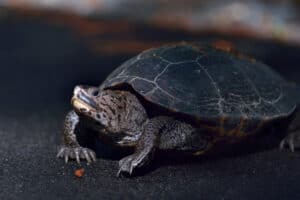
Diamond terrapin turtles, Malaclemys terrapin terrapin, in Latin, are aquatic and commonly found in Southern Maryland along with the coastal areas. It is the only Maryland terrapin turtle species. They spend nearly all their life in the water, preferring marshy areas with slow-moving water and lots of debris and vegetation.
These turtles swim close to the surface and often poke their heads out of the water to breathe.
Diamond terrapins derive their name from the diamond-like pattern of their carapace. Their shell is usually broader towards the back as compared to the front. It also assumes a wedge shape towards the top. While most of these turtles are brown, this may vary from grey to black in some.
These terrapins are also great swimmers and have webbed feet. However, unlike sea turtles, they do not have flippers. They have lachrymal salt glands, which help them survive in saline sea conditions for extended periods.
A mature diamond terrapin achieves a length of between 5 and 7.5 inches, with females being larger than males. They are omnivores in nature but have a preference for meat as compared to vegetation. Diamond terrapins mainly feed on sea animals like sea crustaceans, mollusks, sea insects, and invertebrates. Occasionally, they can be seen feeding on vegetation in the water or near the beach and algae.
Sexual maturity is largely dependent on their sizes as opposed to their ages. Males mature faster than females. Breeding occurs between May and July, and during this time, a female may mate with more than one male. Females are also able to store sperms in their bodies for years. Meaning they do not have to mate every year.
They lay between 10 and 15 eggs per clutch and can have between 3 and 5 clutches every year. Incubation takes between 70 and 80 days, and the hatchlings start emerging in August. Their lifespan is between 20 and 35 years.
2. Bog Turtle
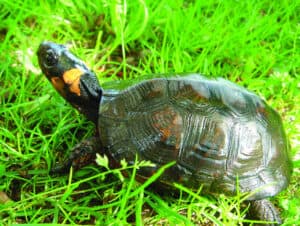
Scientifically they are called Glyptemys muhlenbergii. Bog turtles are considered to be one of the smallest and most endangered turtles in Maryland and worldwide. Their shells are usually black or dark grey in color with no apparent patterns. A distinctive feature, however, is bright orange and sometimes red spots just behind their eyes.
There are different types of water turtles in Maryland, and bog turtles are one of them. They prefer inhabiting the wet meadows, bogs, marshy regions, and slow-flowing ponds with lots of vegetation. They are omnivores, and their diet consists of small fish, amphibians, sea crustaceans, mollusks, and sea vegetation.
A mature bog turtle measures 4 inches and has a life expectancy of up to 40 years. They are critically endangered as a result of the destruction of their habitat and increased demand in the black market for their domestication.
They have low breeding habits as the females only lay a single clutch with a maximum of 3 eggs. They, however, mature pretty fast, between 4 and 6 years. Nesting occurs between May and July, and incubation lasts for 80 to 90 days.
Are you wondering whether you could own a bog turtle? Sadly, the answer is no. It is illegal to own a bog turtle in Maryland. Whether or not you have a permit, you better keep away from these turtles. The law in Maryland prohibits people from owning turtles that are smaller than 4 inches. They are classified as endangered.
3. Eastern mud Turtle
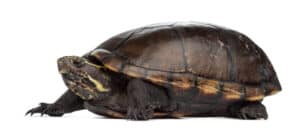
Scientifically Eastern or common mud turtles are called Kinosternon subrubrum. They are endemic in Maryland’s coastal areas. They have plain black or brown shells which lack any distinct characteristics.
Their only major distinguishing features are yellow and, at times, white stripes on their heads. The limbs are usually black, while the plastron may have a whitish or greyish color. A mature Eastern mud turtle measures between 5 and 7 inches.
As the name suggests, Eastern mud turtles prefer locations with mud or soft loamy soils. Their habitat consists of tidal marshes, bogs, ponds, and slow-moving water. Unlike most turtle species, they move about on land but never stray far from a water source.
Eastern mud turtles are omnivores in nature and will feed on snails, invertebrates, mollusks, insects, small fish, aquatic vegetation, and algae.
Breeding in Eastern mud turtles takes place from May and is completed by the end of July. They have a longer incubation period as compared to most turtles at 100 to 110 days. A female will lay between two and five eggs per clutch and one to two clutches every year. Sexual maturity is achieved in 4-7 years in males and 5-8 years in females.
Their lifespan is between 30 and 50 years. One can legally own an eastern mud turtle, and a hatchling goes for between $50 and $100. You, however, need to have prior turtle skills to take proper care of this species.
While Eastern mud turtles are not an endangered species, the draining of wetland in Maryland has greatly impacted their populations.
4. Eastern Box Turtle
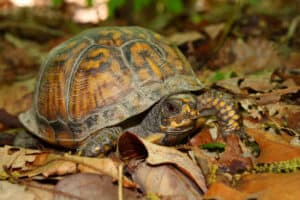
Eastern box turtles go by the scientific name Terrapene Carolina Carolina. One of their most distinctive features is a dome-shaped carapace that is black or brown with spot and yellow markings. They also have the ability to regenerate their plastron in case of an injury.
Their necks and skin are also brown or black but with large blobs that range from brown to red to orange.
Although they are aquatic, Eastern box turtles loam on land in search of food. Sometimes they may walk up to 50 meters a day. However, they never venture more than meters away from their aquatic habitats. Their preferred habitats include shallow ponds, creeks, and marshy regions. They may also be found in open grasslands or in wet forests with a lot of dead vegetation.
Eastern box turtles are omnivores that feed on almost anything they find. However, their main diet includes earthworms, grubs, slugs, beetles, snails, grass, caterpillars, weeds, seeds, fruits, and mushrooms. They have also been known to attack downed birds.
They are pretty small in size, with a mature turtle measuring only between 4 and 6 inches. There are cases, however, where they grow to 7 inches. Eastern box turtles have a lifespan of up to 100 years in the world. While they are well spread over Maryland, their population is declining due to their habitat destruction.
Breeding occurs between the months of May and July. Incubation takes between 70 and 80 days. Eastern box turtles mature slowly, and it takes a female between 7 and 10 years before they start laying eggs. A male turtle may mature slightly earlier by the 6th year.
A female will lay between 3 and 6 eggs per clutch. She may store up sperms for some years if the breeding conditions are not favorable.
Eastern box turtles are not expensive to manage; people with little or no experience can easily take care of them. The average price of a hatchling is between $150 and $400.
5. Common Musk turtle
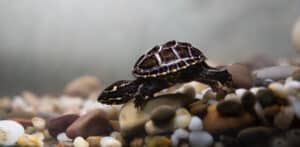
Its scientific name is Sternotherus odoratus. Common musk turtles are nicknamed “stinkpots” owing to the strong odor they release from their musk glands. This helps them repel predators in case they are threatened.
They have a plain appearance and a consistent color. Their carapace is either black or dark brown. A distinguishable feature of these turtles is two white stripes that run along with their heads.
Common musk turtles are small, only reaching between 3 and 4.5 inches when mature. They are mostly aquatic and spend most of their lives in slow moving-water, marshes, shallow creeks, and ponds. Generally, they prefer water bodies with soft bottoms like mud or sand.
They are omnivores, and their diet comprises mostly of small aquatic animals, invertebrates, aquatic insects, algae and aquatic plants, fruits, seeds, and vegetation. This species is well distributed in the state of Maryland.
In musk turtles, breeding occurs between May and August. A female musk turtle will lay up to 9 eggs in a clutch and up to two clutches in a year. A female takes about four years to achieve sexual maturity. A common musk turtle has a lifespan of 50 years.
To acquire a common musk turtle, you will need to pay about $30 and have a good understanding of taking care of turtle pets.
6. Northern Red-bellied Cooter turtle
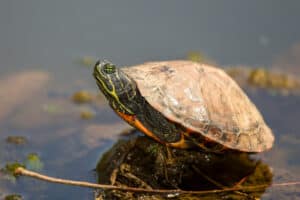
With the scientific name Pseudemys rubriventris, this is considered one of the largest turtles in the US. A mature one can reach an impressive length of 12 inches. Their name is derived from the red color of their plastrons. However, the carapace ranges from olive to dark green to black with orange and sometimes red markings all over. They also have white stripes along the neck and head.
Northern Red-bellied Cooter turtles are aquatic and prefer slow-moving water bodies. They reside in ponds and shallow rivers that are surrounded by lots of vegetation. These turtles are omnivores but heavily lean towards vegetation but will occasionally hunt for little aquatic animals and invertebrates.
Breeding in Northern Red-bellied Cooter turtles occurs between April and July. Nesting happens between May and July. A female Cooter will lay at most two clutches in a year, each holding between 9 and 13 eggs.
Incubation takes between 60 and 90 days and the sex of the hatchlings. Lower temperatures are known to produce male hatchlings while higher produce females. Female Cooter turtles achieve maturity between 15 and 20 years, while males only take around five years.
A Northern Red-bellied Cooter turtle has a lifespan of between 40 and 60 years. With between $30 and $150, one can own this Cooter turtle. You will require some beginner skills to take care of one. Northern Red-bellied Cooter is generally not endangered.
7. Northern Map turtle
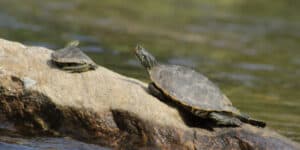
Northern map turtles, Graptemys geographica, are at times referred to as common map turtles. They derive their name from their map-like shell patterns.
Its carapace has an olive green color with keels and rough edges toward the back. Further, it bears intricate thin yellow patterns on the neck and all limbs. Another distinct feature is the bright yellow spots behind each of its eyes. The plastron is cream-yellow with dark lines that seem to disappear with age.
Mature females grow bigger than males. An adult female measures 11 inches, while a male can achieve up to 5 inches. Being aquatic turtles, they prefer shallow and slow-moving waters with soft bottoms. They can be found in ponds, shallow rivers, lakes, and swaps, preferably those with large open areas where they can bask.
They are omnivores in nature. They will feed on aquatic vegetation, fruits, and algae, but their diet is predominantly composed of mollusks and other small aquatic creatures like tadpoles. They are known to live up to 50 years.
Breeding occurs between the months of May and July. A female may lay up to two clutches every year, with each clutch holding between 10-12 eggs. Incubation takes between 70 and 90 days, and a female achieves sexual maturity by the 10th year. Males mature earlier, at about 5-6 years.
A Northern map turtle hatchling is relatively cheap at between $30 and $60. They are low-demanding pets, so even those with little to no pet turtle experience can take care of them. It is, however, illegal to own a Northern map turtle taken from the wild in Maryland.
8. Common Snapping Turtle
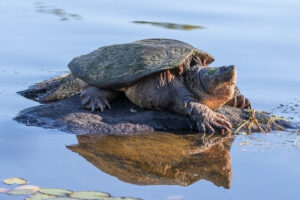
Chelydra serpentine, as it is scientifically called, derives the name “snapping” from its strong beak-like mouth. Their carapace is rough and ridged and has rows of keels. It also varies in color from black to grey to brown. It measures between 10 and 12 inches.
These turtles are known to have long limbs and tails. They also have a stretched neck that is able to move in a nodding manner.
Common snapping turtles are aquatic freshwater turtles. They inhabit any freshwater river, pond, and lake. These snapping turtles are highly mobile, especially when in water. They will dive deep and burrow under soft mud when startled or threatened by a predator.
Common snapping turtles rarely leave the water and are accustomed to an aquatic omnivore diet. They will feed on invertebrates, aquatic insects, small fish, and aquatic vegetation.
Females achieve sexual maturity between the 10th and 15th year. They have a lifespan of about 30-40 years in captivity, but under good conditions, they can achieve up to 100 years. Mating occurs from April, while nesting happens from July.
A clutch contains between 20-40 eggs. Incubation takes between 90 and 100 days. Their eggs and hatchlings are usually exposed to a number of predators, especially raccoons.
Maryland snapping turtle laws allow you only to keep a maximum of one snapping turtle. You are also not allowed to own a snapping turtle that measures less than 4 inches in length.
Good turtle skills are necessary when taking care of a snapping turn, as they are known to turn aggressive when mishandled. They are relatively cheap; at $30-$40, you can get a juvenile.
9. Painted Turtle
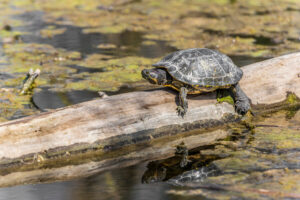
The painted turtles are aquatic mid-sized turtles. They are divided into two main subcategories; the Midland painted with the scientific name Chrysemys picta marginata, and the other is the Eastern painted with the scientific name Chrysemys picta picta.
Painted turtles have a darker color along with the shells as compared to the eastern painted turtles. They also have a distinctive large dark patch on the plastrons.
They have a consistent color on both their shell and the rest of the body. It ranges from dark olive to black. Their heads are a bit darker than the rest of the body, with a few orange or reddish marks. A mature painted turtle measures between 4 and 6 inches.
Painted turtles are aquatic, and most of their lives are spent in the water. They can be found in lakes, ponds, and slow-moving rivers with a soft bottom. During wither, the turtles hibernate by hiding underneath the mud. Their diet is mainly omnivorous, and it consists of aquatic insects, crustaceans, algae, and aquatic vegetation.
Painted turtles breed in the months of April to September. A female turtle will lay between 4 to 10 eggs per clutch from May to July. Incubation then takes between 70 and 90 days. Males achieve sexual maturity than females and take between 2-9 years, while females may take 16 years. The lifespan of painted turtles is between 30-40 years.
A painted turtle is a low-maintenance pet and requires very little skills. Anyone who has ever take care of a turtle will have an easy time petting one. Juvenile-painted turtles cost between $20 and $50.
10. Spotted turtle
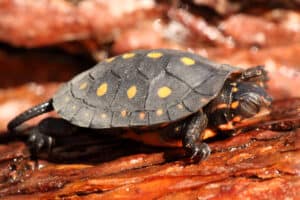
Spotted turtle, Clemmys guttata, is one of the most colorful pets in the US. It has a smooth upper shell with bright yellow spots. The spotting extends to its skin. Its shell is bluish, and in some turtles, it is black.
Its attractiveness and charisma make it one of the most preferred pet turtles. This has greatly contributed to their declining numbers in Maryland. The plastron in these turtles is a creamy yellow color with some large dark markings. A mature spotted turtle measures 3-4 inches.
Spotted turtles are aquatic and are commonly found near marshes, coastal wetlands, bogs, and small ponds with soft bottoms. During hibernation, they burrow in the mud where water levels have a depth of between 50 and 100 cm. They rarely leave the water other than when laying eggs or once they are through hibernating, and even then, it is usually for a short time only.
Female spotted turtles mature after 12 to 20 years. However, like with most other turtle species, maturity is mostly determined by the size and not age. They are also able to store sperms in their bodies for a number of years.
Breeding happens between May and July. A female spotted turtle will lay between 3 and 7 eggs per clutch. Incubation lasts for about 80-90 days. Hatchlings start emerging in early September.
Spotted turtles are omnivores in nature, and they mostly feed on aquatic insects, aquatic vegetation, snails, and invertebrates. On average, spotted turtles are known to live up to 50 years, although some have lived longer.
11. Spiny softshell turtle
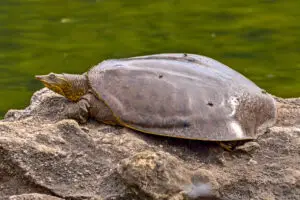
One of the turtle’s most distinct features is that its shell is flattened, rubbery, and round. As the name suggests, its carapace is smooth compared to most turtles. The shell is dark olive or black in color with some spots. These spots, however, tend to disappear as the turtle grows older.
Mature males attain a size of between 5 and 9 inches while females are bigger, reaching between 12 and 20 inches.
Spiny softshell turtles are aquatic in nature. They can be found in large streams, rivers, reservoirs, and any other place where there is a water body but little vegetation. When threatened, they burrow their bodies under the sand, leaving only their heads exposed.
These turtles are carnivorous, and their diet comprises small fish, crayfish, aquatic invertebrates, and other aquatic animals. Hunting mostly occurs in the water.
They are great swimmers, which makes it easy for them to hunt. Swimming is aided by their long, webbed feet. This turtle is also able to breathe underwater through the skin, pharyngeal and cloacal linings.
Breeding in spiny softshell turtles occurs between May and July. Each year, a female will lay a clutch containing between 4 and 38 eggs that hide under the sand or loose soil. The eggs take between 60 and 80 days to hatch.
Sexual maturity in females is achieved by the 10th, while the males will mature by the 6th year. The lifespan of a spiny softshell is up to 50 years. Their main threats are habitat destruction and industrial pollution.
12. Wood turtle
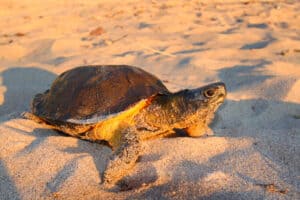
Wood turtles, Glyptemys insculpta, have a greyish, brownish, or black carapace that is slightly domed. The scutes on the carapace are sculpted and knobbed. Their plastron is unhinged light brown or orange with black patches at the edges. The plastron in males is concave while flat in females. Their length ranges from 6 to 10 inches.
Wood turtles are aquatic, residing in or next to slow-moving water bodies. They prefer water bodies with a medium depth of between 2 and 10 meters with hard bottoms. These turtles are majorly found in heavily vegetated surroundings.
Their diet consists of strawberries, raspberries, grasses, and any other soft vegetation. They will also feed on slugs, worms, and invertebrates.
Wood turtles are said to be extremely intelligent. They have been known to stump their feet on the ground to trick earthworms into thinking it is raining. Once they come up to the surface, the turtles feed on them.
Breeding in wood turtles occurs between May and June. Females lay between 6 and 8 eggs per clutch. Incubation takes between 70 and 90 days. Hatchlings emerge between September and October. Sexual maturity is achieved between the 14th and 20th years. They have a lifespan of about 60 years.
This turtle is considered to be one of the aggressive types, with females being more aggressive than males. Older males are also to portray aggression towards the younger ones, especially during mating. This means that those that wish to adopt one as a pet need to have some turtle-keeping skills.
In Maryland, you can only own only one wood turtle without a permit. With a permit, however, you can own an unlimited number. It is also unlawful to own wood turtles from the wild. The average price of a hatchling wood turtle is $250-$500.
13. Red-eared slider
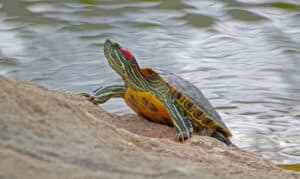
Trachemys scripta elegans is this turtle’s scientific name. They are not natives of the state of Maryland. They are commonly found in the northern, central, and southern parts of the state, as far as Prince George county. They are a result of people releasing their pet turtles into the wild. Ironically, they are considered as one of the most common turtles in Maryland.
As its name suggests, they have a unique red stripe behind their eyes. At times, the stripe has a yellow color. Its carapace ranges from yellow to dark green or sometimes brown with some markings. It is oval and slightly domed. The plastron is yellowish-brown with some dark markings.
The red-eared slider’s size ranges from 8 to 13 inches, but there have been records of some measuring up to 15 inches. Males are slightly smaller than females but possess longer claws and tails.
Being freshwater aquatic turtles, they are commonly found in marshes, lakes, streams, and shallow rivers with abundant vegetation and rocks nearby for basking.
They are omnivorous, feeding on invertebrates, small fish, aquatic vegetation, aquatic insects, and other small aquatic creatures. While they may be found outside water when foraging or basking, they never venture very far from a water body. Their lifespan varies between 20 and 50 years.
Breeding occurs between April and July. Females will reach maturity between the ages of 5 and 7 years or after achieving 6 inches, while males achieve maturity by the 5th year or after achieving 3 inches in length. A female will lay between 2 to 3 clutches every breeding season. Each clutch holds between 4-15 eggs, while incubation takes between 55 and 80 days.
As a pet, they are a bit aggressive, and hence you will need some good skills to take care of. Also, something worth noting is that they are highly invasive owing to their high breeding rates. As such, it is illegal in Maryland to release them in the wild. The average price of a hatchling is between $15 and $50.
Conclusion
There are 13 turtle species in Maryland. From the above list, 3 of the turtles are placed under the endangered status. These are snapping turtles, bog turtles, and Northern map turtles. Spiny softshell are considered rare turtles that should be conserved. Maryland turtle species are diverse in both their features and origin.
The population of most species in the above list has been steadily declining. For that reason, the state of Maryland has taken measures to ensure that the turtles are taken care of. Some of these measures including outlawing owning of endangered species and limiting the number of turtles that one can own. All these measures are meant to bolster the population of these species.
For pet turtle enthusiasts, it is important to be aware of the laws put in place and ensure that you uphold them. In addition, should you want to release the pet turtles, you need to consult the relevant department to ensure that you do it the right way. Red-eared sliders are a good example of what irresponsible releasing of pets into the wild can do to their ecology.